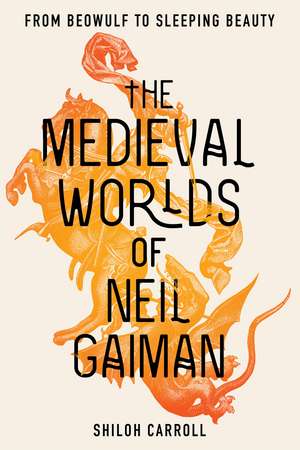The Medieval Worlds of Neil Gaiman: From Beowulf to Sleeping Beauty
Autor Shiloh Carrollen Paperback – 26 sep 2023 – vârsta ani
Readers love to sink into Gaiman’s medieval worlds—but what makes them “medieval”? Shiloh Carroll offers an introduction to the idea of medievalism, how the literature and culture of the Middle Ages have been reinterpreted and repurposed over the centuries, and how the layers of interpretation have impacted Gaiman’s own use of medieval material. She examines influences from Norse mythology and Beowulf to medieval romances and fairy tales in order to expand readers’ understanding and appreciation of Gaiman’s work, as well as the rest of the medievalist films, TV shows, and books that are so popular today.
Preț: 153.13 lei
Nou
Puncte Express: 230
Preț estimativ în valută:
29.30€ • 30.67$ • 24.24£
29.30€ • 30.67$ • 24.24£
Carte disponibilă
Livrare economică 15-29 martie
Preluare comenzi: 021 569.72.76
Specificații
ISBN-13: 9781609389130
ISBN-10: 1609389131
Pagini: 222
Ilustrații: 6 b&w images
Dimensiuni: 152 x 229 x 28 mm
Greutate: 0.5 kg
Editura: University of Iowa Press
Colecția University Of Iowa Press
ISBN-10: 1609389131
Pagini: 222
Ilustrații: 6 b&w images
Dimensiuni: 152 x 229 x 28 mm
Greutate: 0.5 kg
Editura: University of Iowa Press
Colecția University Of Iowa Press
Recenzii
“Illuminating and provocative by turns, this book is a fascinating deep dive into Neil Gaiman’s many medieval inspirations, ranging from Old Norse myth to morality play to folktale. Carroll’s work inventively rereads well-known medieval texts alongside Gaiman’s eclectic and creative reimagining of them in comic, novel, short story, and film.”—Carolyne Larrington, author, The Norse Myths that Shape the Way We Think
“With clarity and humor, Carroll puts Neil Gaiman’s works in conversation with chronicle histories, dream-vision poetry, saints’ lives, folktales, and other medieval (and medievalist) texts, drawing out chains of influence and reinterpretation. Like Gaiman himself, this book is accessible to the medievalist, the speculative fiction fan, and everyone in between.”—Kavita Mudan Finn, author, The Last Plantagenet Consorts: Gender, Genre, and Historiography, 1440–1627
“An accessible survey of medieval influences across Gaiman’s work, imbued with Carroll’s humor and fresh voice. It provides historical and literary context for prominent themes and characters in Gaiman’s most famous stories, as well as analysis of lesser-studied works such as The Books of Magic and the 2007 film Beowulf.”—Tara Prescott-Johnson, author, Neil Gaiman in the 21st Century: Essays on the Novels, Children’s Stories, Online Writings, Comics and Other Works
“With clarity and humor, Carroll puts Neil Gaiman’s works in conversation with chronicle histories, dream-vision poetry, saints’ lives, folktales, and other medieval (and medievalist) texts, drawing out chains of influence and reinterpretation. Like Gaiman himself, this book is accessible to the medievalist, the speculative fiction fan, and everyone in between.”—Kavita Mudan Finn, author, The Last Plantagenet Consorts: Gender, Genre, and Historiography, 1440–1627
“An accessible survey of medieval influences across Gaiman’s work, imbued with Carroll’s humor and fresh voice. It provides historical and literary context for prominent themes and characters in Gaiman’s most famous stories, as well as analysis of lesser-studied works such as The Books of Magic and the 2007 film Beowulf.”—Tara Prescott-Johnson, author, Neil Gaiman in the 21st Century: Essays on the Novels, Children’s Stories, Online Writings, Comics and Other Works
Notă biografică
Shiloh Carroll is author of Medievalism in A Song of Ice and Fire and Game of Thrones. She lives in Nashville, Tennessee.
Descriere
Readers love to sink into Neil Gaiman’s medieval worlds—but what makes them “medieval”? Shiloh Carroll offers an introduction to the idea of medievalism, how the literature and culture of the Middle Ages have been reinterpreted and repurposed over the centuries, and how the layers of interpretation have impacted Gaiman’s own use of medieval material.
